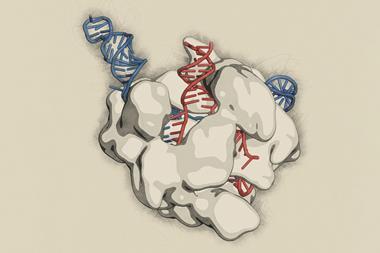A set of reactions operating silently inside live cells or whole animals are lighting up chemical biology and inspiring new medicines, James Mitchell Crow finds
Few pieces of research transition from idea to reality quite so swiftly as a particular project from Carolyn Bertozzi’s lab in the early 2000s. But sometimes, things just click. The team was looking for new reactions that could be used to selectively tag target biomolecules inside living cells, when Bertozzi struck upon the idea of using strained substrates to drive reactivity.
‘I have never had another paper like it,’ says Jennifer Prescher, who was a graduate student in Bertozzi’s University of California, Berkeley, research group at the time. ‘The reviews were just like, “publish immediately”,’ she says. ‘The concept then drove a lot of work in the field.’
Today, that concept has carried all the way to human use. Strain-driven bioorthogonal chemistry is now being tested in a first-in-human clinical trial of an experimental anticancer therapeutic that selectively releases the drug at the tumour site.
Twenty years ago, the idea of bioorthogonal chemistry didn’t exist, says Prescher, who since 2010 has headed a lab at University of California, Irvine. ‘Now, some of the chemistries have been used in people.’
Can I click it?
The reaction conditions carefully curated inside an organic chemist’s round-bottomed flask could not be much more different to the environment inside a living cell. Take away the carefully dried organic solvent, the inert atmosphere, tailored temperature and highly purified reactants and reagents. In their place, add a gently warmed water-based soup of ions and molecules alive with chemical activity.
There were gaps in how we manipulate biomolecules in living systems. That’s how bioorthogonal chemistry started to emerge
Bioorthogonal chemistry is the discovery and application of reactions that will proceed swiftly and selectively even under these conditions, without perturbing the biochemistry abuzz all around it.
‘As knowledge has increased in chemistry and biology, people naturally start to work at the interface and explore the frontiers,’ says Peng Chen, a chemical biology researcher at Peking University in Beijing, China. ‘There are still gaps, in particular in how we manipulate biomolecules in living systems. That’s how bioorthogonal chemistry started to emerge.’
The original motivation for reactions that could quietly operate within living systems was to develop chemical tools to study biological processes in molecular detail. Previously, proteins could be studied in situ by genetically encoding them to incorporate green fluorescent protein or its variants. But the tags are bulky, potentially altering the result. And only studying proteins ignored the multiple other classes of biomolecule also critical to cellular biology and to disease.
Bertozzi’s lab – which relocated to Stanford in 2015 – has a longstanding interest in cell surface sugars, and the changing patterns of glycosylation associated with infection, inflammation and cancers. Bioorthogonal chemistry, in the form of two small molecules that will react exclusively with each other in a cellular setting to form a new covalent bond between them, represents a way around the problem. One member of the duo could be attached to a sugar of interest, and the other could be linked to a chemical reporter such as a fluorescent tag. When the two partners come together, the tagged sugar can be studied in its native environment.
Early attempts at such ligation reactions typically involved carbonyls, but were limited by cross-reaction with carbonyl-bearing metabolites naturally present in cells. In 2000, Bertozzi published the work that arguably launched the bioorthogonal field, with her twist on the venerable Staudinger reaction between triarylphosphines and organic azides – two functional groups not found in mammalian cells. The classic Staudinger generates an unstable aza-ylid, which readily hydrolyses in the presence of water. In the new version, Bertozzi incorporated a methyl ester to the triarylphosphine, to trap the aza-ylid in an intramolecular cyclization. The resulting amide bond stably linked the two starting materials together, enabling selective tagging of cell surface sugars.
Yes, you can
‘I joined the lab right after the Staudinger ligation was published,’ says Prescher. ‘I’d thought I would be going to grad school to do natural product total synthesis – and then on a graduate student recruiting visit, I met this young powerhouse professor who had what I thought were super-cool ideas.’
Prescher’s PhD project aimed to use this new chemistry to explore non-natural sugars as potential cancer vaccines. ‘It turns out, there was a lot to be learned just on the metabolism of these non-natural sugars and their presentation on cell surfaces,’ she says. ‘We got to thinking, could we image these altered forms of glycosylation in a living animal?’
Using Staudinger ligation chemistry, the team conducted the first bioorthogonal reaction inside a live mouse. ‘We were able to run the reaction inside the animal,’ Prescher says. ‘But it was so slow, we could not use it for imaging.’ For whole animal studies, the Staudinger’s slow reaction rate meant having to inject a lot of reagent to drive the reaction forward, which caused the problem of unbound probe lighting up. A new approach for whole animal studies was going to be needed.
Around the same time, other chemistries with bioorthogonal promise were starting to appear. The quintessential click reaction, the copper-catalysed azide–alkyne cycloaddition (CuAAC), was first published in 2002 by the Meldal and Sharpless labs. Reactions that adhere to click chemistry principles of selectivity, high yield and broad scope were originally envisioned as a tool for organic synthesis. But click reactions could be highly amenable to biological applications, if they involved functional groups completely different – orthogonal – to those generally found in cells. For mammalian research, azides and alkynes fall into that category.
Would a strained alkyne be so reactive that the copper was not needed?
As with the Staudinger, the CuAAC was a new twist on old reaction, based on the discovery that catalytic copper accelerated the process 100 million-fold. ‘This captured lots of people’s attention,’ Prescher says. The reaction was particularly intriguing because it involved two small functional groups, potentially easier to incorporate without disrupting the natural processes of the biomolecule to be tagged. But this chemistry wasn’t immediately applicable to live animal imaging either. The original copper catalysts generated toxic levels of reactive oxygen species in cells. ‘And having three things needing to converge in an area is difficult in a whole animal,’ she says.
But a copper-free click reaction might do the trick. ‘I happened to be in the lab late in the evening, when Carolyn came in from a physical society meeting, talking about these wacky strained molecules that had been discussed,’ Prescher says. Would a strained alkyne be so reactive that the copper was not needed? The team hit the library, searching for precedents. ‘We came upon this paper, still in German, but you could read the words phenyl azide, cyclooctyne and explosion,’ she says. A promising phrase when you are looking to add a bit of zip to a reaction rate.
A linear alkyne has a 180° bond angle, but in a cyclooctyne – the smallest generally isolable strained alkyne – the cyclic structure bends the angle down to 160°, distorted favourably toward the reaction transition state. Strained substrates proved highly amenable to copper-free click chemistry. ‘We made the molecule, tested it on proteins, then on cells, just within the span of a few months,’ Prescher says.’
After the rapid development and publication of the initial copper-free click bioorthogonal reaction, the team explored ways to further boost reaction rate, including the addition of fluorine substituents to the cyclooctyne. ‘It was a really exciting time being in [Bertozzi’s] lab,’ recalls Jeremy Baskin, now at Cornell University in New York, whose own PhD work in the group focussed on developing new cyclooctyne reagents with faster reaction kinetics, and applying them for specific tagging reactions. Bioorthogonal-based imaging in living organisms became possible. ‘In zebrafish imaging experiments, we could see the glycans get labelled at the cell surface and then internalised through endocytosis and trafficked to different organelles in the cell,’ Baskin says.
Take the strain
Joseph Fox began his career as a traditional organic chemist, with a particular interest in the chemistry of strained molecules. When Bertozzi’s group published the first paper in strain-driven bioorthogonal chemistry, Fox already had a lab full of strained molecules at the University of Delaware, US. ‘I was in an ideal position to start exploring this chemistry,’ Fox says.
One reaction familiar to Fox was the inverse electron demand Diels–Alder between strained alkenes and tetrazines, a reaction noted for its exceptionally fast kinetics. Neither functional group is naturally found in mammalian cells, suggesting bioorthogonal potential. In 2008, Fox and his team published the bioorthogonal reaction between tetrazine and transcyclooctene (TCO). Tetrazine ligation remains the fastest bioorthogonal reaction, enhanced by subsequent development such as the bicyclic cyclooctene–cyclopropane systems Fox designed based on computer-aided conformational analysis. ‘The three-membered ring is not just adding on strain, it is making the ring pucker into an unnatural conformation that makes the double bond more reactive,’ Fox says. ‘With the most reactive trans-cyclooctenes, the rates are greater than 3,300,000 M–1s–1 – that’s fast!’
Prescher’s group is among those who have since contributed to this chemistry, showing that cyclopropenes are the smallest ring-strained dienophiles that can participate in tetrazine ligation. ‘I am always inspired by the functional groups you find in non-mammalian life,’ Prescher says. ‘They make such a diverse array of molecules that humans don’t make. Cyclopropenes are part of many microbial natural products, and because they exist in those organisms you know they have at least some degree of metabolic stability so could be a good starting point. There is quite a bit of diversity out there yet, waiting to be harnessed in this way.’
In the Fox lab, one focus has been to improve access to TCOs. ‘The chemistry to make strained molecules is quite specialised, but it has actually been adopted pretty broadly, which I think speaks to how badly people want these molecules,’ Fox says. The team’s photochemical flow method for making TCOs has been adopted by groups around the world. ‘It is a pretty unique closed-loop reactor where you capture the product in-line, using affinity chromatography, to drive an otherwise unfavourable equilibrium.’
Recent work has been conducted in collaboration with Pfizer. ‘They are interested in studying what happens after a drug engages its protein target, as a function of time,’ Fox says. In early 2022 the team published a light-activated version of tetrazine ligation that offered temporal and spatial control over protein imaging. ‘You have a precursor dihydrotetrazine that is unreactive, and in response to a photocatalyst in light you can switch it on,’ Fox explains. ‘You can focus light with very high resolution and do a type of photolithography, make patterns or write letters inside the nucleus of a living cell. We want to use it for studying biomolecular movement as a function of real time in live cell context.’
Right tool for the task
As well as strain-based reactions and the Staudinger ligation, bio-friendly copper catalysts for the CuAAC click reaction have been developed featuring water-soluble ligands that stabilise the metal and supress ROS formation in live cells or animals. Palladium and ruthenium coupling reactions between azides and aryl iodides have also been deployed.
Lipid cell biology is a fertile ground for bioorthogonal chemistry
Developing a suite of bioorthogonal chemistries has been key to the success of the field, Prescher says. ‘I like to think of these reactions as spanning a spectrum of chemistry, which is important as long as we know how to use them and what their strengths and weaknesses are.’
In Baskin’s lab, a range of bioorthogonal chemistries are deployed. ‘Over my career I have shifted from being a developer to a user of bioorthogonal probes and we’ve really taken advantage of reaction development over the last two decades,’ he says. After studying cell surface sugars during his PhD, Baskin became fascinated by the lipids that cellular membranes are made from. ‘Lipid cell biology is a fertile ground for bioorthogonal chemistry,’ he says.
As well as the abundant phospholipids that are the main structural element of biological membranes, trace membrane phospholipids play a role in cell signalling. ‘We are interested in a signalling lipid called phosphatidic acid (PA),’ Baskin says. ‘Its production is upregulated in many cancers, its production is induced during bacterial and viral infections, and its levels are altered in neurodegenerative disease,’ he says. ‘We are driven by the question of how one type of molecule has all these different responses – how cells get specificity out of all of this.’ The spatial and temporal context is key, the team has shown.
You need really rapid bioorthogonal chemistry to tag these lipids
To study PA, Baskin makes use of the fact that the enzyme that makes it, phospholipase D (PLD), prefers alcohols to water. The reaction usually involves hydrolysis of a PA lipid precursor, but offer the enzyme a primary alcohol bearing a clickable handle, and it will attach that to the PA it makes instead. ‘Whether we use azido groups or alkyne groups, or even the transcyclooctene groups, those modified primary alcohols are still accepted by the PLD,’ Baskin says.
The clickable group selected depends upon the application. For subcellular studies such as lipid trafficking, speed is of the essence. ‘Lipids move around the cell a lot faster than people thought – they defuse within a bilayer on the sub-second timescale and can traffic between different organelles on the sub-minute timescale – so you need really rapid bioorthogonal chemistry to tag these lipids in the place they were originally made,’ Baskin says. ‘For that we use inverse electron demand Diels–Alder chemistry, the tetrazine ligation.’
But for applications where imaging is conducted at the cellular level, other approaches are better suited. ‘Then we will use azide–cyclooctyne reaction. There, because the alcohol has a smaller bioorthogonal group on it, we can get more labelling,’ Baskin says. In one recent study, the team used genome-wide Crispr interference to randomly knock down genes in cells, then used cyclooctyne-based bioorthogonal whole-cell fluorescence imaging to measure how PLD/PA signalling had been affected. ‘We identified a connection between the famous cancer-related kinase, GSK3, and the PLD pathway,’ Baskin says. As well as this potential cancer link, the team identified 160 other putative regulators of the PLD/PA signalling pathway. ‘Bioorthogonal chemistry excels at widening your perspective, at taking the blinders off,’ Baskin says.
In another recent example showing just that, Bertozzi and her Stanford colleague Ryan Flynn used azide–cyclooctyne copper-free click chemistry to detect glycol-RNAs – RNAs decorated with sugars – on the surface of living cells. The discovery challenges both the idea that RNAs are not glycosylated in the cell, and that RNAs are not found on the cell surface.
Breaking free
Bioorthogonal bond-forming reactions have enabled huge advances in bioconjugation, labelling and imaging in live cells and animals. But from a chemical perspective, bond-forming reactions are only half the story. ‘We started thinking, why can’t we utilise bond cleavage reactions?’ Chen says. ‘Cleavage-type reactions offer the possibility for activation of proteins, release of drugs, where we need a biocompatible on-demand approach.’
Akin to the functional group deprotection strategies used in organic synthesis, Chen has developed proteins in which a key residue in the active site is ‘caged’ with a kind of protecting group that blocks the protein’s activity. The cage can be clipped off using a bioorthogonal bond-breaking reaction, deprotecting the protein and switching it on. ‘Our first example, back in 2014, used palladium-mediated decaging chemistry,’ says Peng. Palladium cleaved a propargyl carbamate from a caged lysine residue in the active site. ‘That was the first example of metal deprotection on a biomolecule that demonstrated gain of function, showing we can manipulate protein activity in a living cell.’
Metal-based protein decaging is still pursued in Chen’s lab. One advantage is that metals can be used as light-triggered photocatalysts to initiate decaging. ‘The beauty of this approach is that you can use it in one location inside the cell, giving you spatial control,’ says Chen. ‘Our most recent paper used photocatalysis for subcellular proteome profiling.’
Metals also offer the potential for catalytic bioorthogonal chemistry. ‘So far no one has really demonstrated the catalytic power of such reactions in living systems – we may even add more than stoichiometric amounts of the metal due to the complex nature in cells. Catalytic loading is something we are exploring.’
Metal-free bioorthogonal bond breaking has also been achieved, mainly by adapting reactions proven for bioorthogonal bond forming. In 2013, a team led by Marc Robillard of Tagworks Pharmaceuticals in The Netherlands showed TCO–tetrazine chemistry could be adapted for bond breaking. If a carbamate is attached to TCO at the allylic position, this side group will be released as a free amine via rearrangements triggered by the cycloaddition. This reaction could be used to release anticancer drug doxorubicin on demand in living cells, the team showed.
Within a tumour cell we could selectively activate the protein using UV light
Chen has used a similar TCO–tetrazine approach to decage proteins such as caspase 3, a signalling protein that activates programmed cell death. ‘We showed this will trigger cell death within 30–60 minutes,’ Chen says. ‘In this time window we identified the substrates digested by this cell death caspase, particularly those early events.’
On the therapeutic side, the chemistry allows the concept of ‘prodrugs’ – masked therapeutics that only assume their active form in situ – to be extended from small molecules to include protein therapeutics, Chen has shown. ‘People were able to make small molecule prodrugs because they had better controllability over small molecule synthesis, compared to proteins,’ Chen says. ‘Now we have that ability with proteins too.’ The team has developed a computational tool to identify suitable lysine or tyrosine residues in or near the active site that will block protein activity until uncaged. In 2019, the team used this chemistry to block a key catalytic residue in an anthrax toxin. ‘Within a tumour cell we could selectively activate the protein using UV light,’ says Chen. Other triggers are currently under investigation.
Precedents from small molecule drug development suggest the strategy has strong clinical potential. ‘A few companies are now using this chemistry for prodrug applications, and last year the bioorthogonal decaging reaction of a small molecule drug entered clinical trials in the US. That really shows its promise not only in cells but in a living human setting,’ Chen says.
In October 2020, California-based biotech Shasqi initiated this first human use of bioorthogonal chemistry, starting a Phase 1/2 clinical trial of a doxorubicin prodrug that exploits the tetrazine–TCO chemistry Fox developed and Robillard adapted. The treatment is based on the pre-injection of a tetrazine-loaded hydrogel into the tumour site, followed by infusions of the doxorubicin prodrug. Only where the two components meet, at the tumour site, is the drug unleashed.
Doxorubicin is used to treat multiple cancers but can often be limited by toxic side effects. In mice, the prodrug strategy boosted the tolerable dose nearly 6-fold, increasing survival by 63%. The clinical trial is yet to complete, but the company is already planning antibody-based approaches, so that tumours that cannot be reached by injection could still be decorated with tetrazines. ‘It is the first bioorthogonal chemistry to have been done in humans, and it has been wonderful to see that story develop,’ Fox says.
James Mitchell Crow is a science writer based in Melbourne, Australia















No comments yet